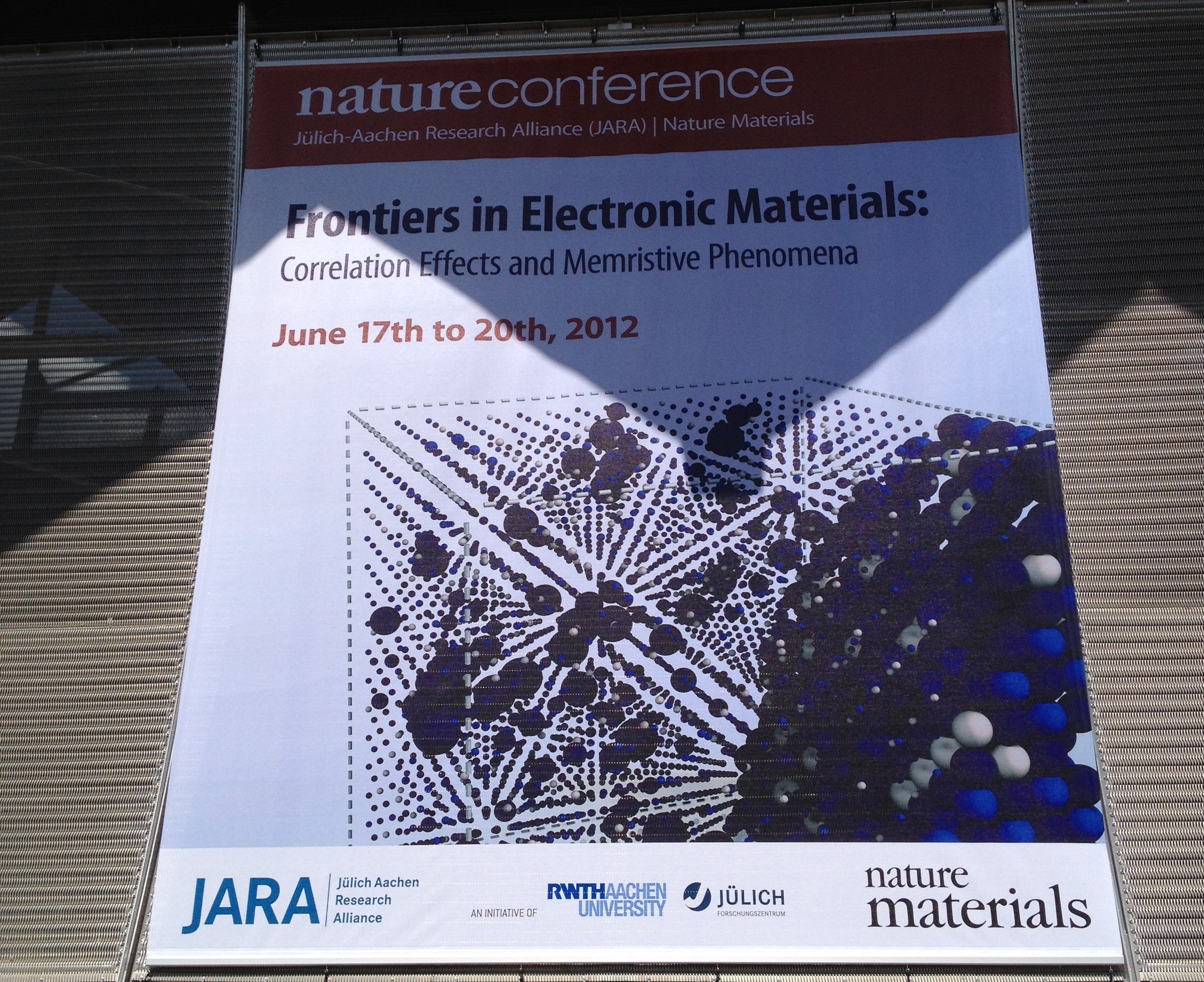 For the past weeks this blog has been more quiet than usual. Mostly, I was busy with a number of projects, including the co-organisation of a Nature Conference – ‘Frontiers in Electronic Materials: Correlation Effects and Memristive Phenomena‘. The conference took place in Aachen/Germany, and was organized in collaboration with the Jülich-Aachen Research Alliance (JARA) formed by the RWTH Aachen University and the Helmholtz research centre in Jülich – who did a great job in getting this meeting off the ground. Rainer Waser in particular dedicated a tremendous amount of work to the conference. And with close to 600 attendees, the popularity of the conference certainly exceeded all our expectations.
For the past weeks this blog has been more quiet than usual. Mostly, I was busy with a number of projects, including the co-organisation of a Nature Conference – ‘Frontiers in Electronic Materials: Correlation Effects and Memristive Phenomena‘. The conference took place in Aachen/Germany, and was organized in collaboration with the Jülich-Aachen Research Alliance (JARA) formed by the RWTH Aachen University and the Helmholtz research centre in Jülich – who did a great job in getting this meeting off the ground. Rainer Waser in particular dedicated a tremendous amount of work to the conference. And with close to 600 attendees, the popularity of the conference certainly exceeded all our expectations.
I do not intend to summarize all the interesting talks at the conference here. Instead, I like to focus on two aspects that I think contributed in particular to the success of the conference, and that could be of interest also to those that couldn’t attend the meeting. They’re related to the scope of the conference and its organisation. […]
Continue reading...

A scanning tunnelling microscope image of a single-atom transistor during fabrication. The pink colours represent the areas where a single phosphorus atom (centre) as well as phosphorus source and drain contacts will be placed. The gate contacts that control the transistor action from the side are not visible here. Credit: Martin Fuechsle
When Gordon Moore made his observation in 1965 that the number of transistors integrated on a single silicon chip is doubling roughly every two years, the only logical end point for such a trend would be a transistor made from a single atom. This point has now been reached. Writing in Nature Nanotechnology, Michelle Simmons from the University of New South Wales in Sydney and colleagues report a single-atom transistor, the world’s smallest, on a silicon chip. The transistor is based on current flowing through a single atom of phosphorus embedded in a silicon wafer. […]
Continue reading...

A beautifully looking graphics, isn’t it? But there is a major caveat. As its creators would agree, this image is only a very crude depiction of reality and shouldn’t be used for any scientific purpose… (c) LANES, EPFL
Nanotechnology is a wonderful science that has pushed functional devices to sizes not far away from the size of atoms. So small that if you want to image such structures, even a conventional electron microscope wouldn’t get you far. There is no way to directly see what is going on. This is a common problem. Take condensed matter physics – it is impossible to directly visualize the various interactions and events taking place inside a crystal. Or photonics, where complex light fields interact with tiny nanostructures in ways that can be really difficult to visualize, especially in real-time.
So, no wonder that artificial graphics often serve to illustrate a scientific concept or a certain device. And with the prevalence of advanced computer graphics programs such illustrations are becoming more and more fancy. In my opinion, this is a dangerous trend, because such graphics can distort the underlying science they try to depict. […]
Continue reading...
 For the past weeks this blog has been more quiet than usual. Mostly, I was busy with a number of projects, including the co-organisation of a Nature Conference – ‘Frontiers in Electronic Materials: Correlation Effects and Memristive Phenomena‘. The conference took place in Aachen/Germany, and was organized in collaboration with the Jülich-Aachen Research Alliance (JARA) formed by the RWTH Aachen University and the Helmholtz research centre in Jülich – who did a great job in getting this meeting off the ground. Rainer Waser in particular dedicated a tremendous amount of work to the conference. And with close to 600 attendees, the popularity of the conference certainly exceeded all our expectations.
For the past weeks this blog has been more quiet than usual. Mostly, I was busy with a number of projects, including the co-organisation of a Nature Conference – ‘Frontiers in Electronic Materials: Correlation Effects and Memristive Phenomena‘. The conference took place in Aachen/Germany, and was organized in collaboration with the Jülich-Aachen Research Alliance (JARA) formed by the RWTH Aachen University and the Helmholtz research centre in Jülich – who did a great job in getting this meeting off the ground. Rainer Waser in particular dedicated a tremendous amount of work to the conference. And with close to 600 attendees, the popularity of the conference certainly exceeded all our expectations.



June 27, 2012
2 Comments